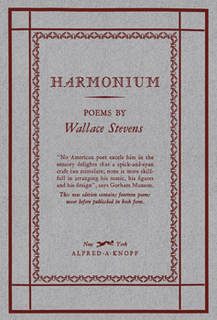Media
 | Life is Motion (0:41) |
Problems playing this file? See media help. | |
"Life is Motion" is a poem from Wallace Stevens's first book of poetry, Harmonium. It was first published in 1919, so it is in the public domain. [1]
In Oklahoma,
Bonnie and Josie,
Dressed in calico,
Danced around a stump.
They cried,
"Ohoyaho,
Ohoo"...
Celebrating the marriage
Of flesh and air.
This playful poem is notable for its introducing exclamatory sounds, and for evoking the American frontier and the simple joy of calico-clad Bonnie and Josie. Stevens returns to Oklahoma, the venue for the first poem in Harmonium, "Earthy Anecdote", which charged a local scene with an aura of mystery. "Life is Motion" by contrast reduces locale to basics, suggesting in its own way that the poet must move beyond it as Crispin did in "The Comedian as the Letter C", even as this marriage of flesh and air is celebrated.
A symbolist reading would understand the flesh as reality, the air as imagination. The poem celebrates Stevens's task, to engage his imagination with reality.
A philosophically ambitious reading would view it as a poetic expression of a process philosophy like that of Alfred North Whitehead.
One critic wrote: "Of the modern poets, Wallace Stevens seem to me the most successful creator of artistic experiences which hum with the energy and motion of life." [2] See also "Metaphors of a Magnifico", where the debt to Cubist studies of motion is particularly evident.

Harmonium is a book of poetry by American poet Wallace Stevens. His first book at the age of forty-four, it was published in 1923 by Knopf in an edition of 1500 copies. This collection comprises 85 poems, ranging in length from just a few lines to several hundred. Harmonium was reissued in 1931 with three poems omitted and fourteen new poems added.
"The Worms at Heaven's Gate" is a poem from Wallace Stevens' first book of poetry, Harmonium (1923). It was first published in 1916 and is therefore in the public domain.
"Peter Quince at the Clavier" is a poem from Wallace Stevens's first book of poetry, Harmonium. The poem was first published in 1915 in the "little magazine" Others: A Magazine of the New Verse, edited by Alfred Kreymborg.
"Ploughing on Sunday" is a poem from Wallace Stevens's first book of poetry, Harmonium (1923). First published in 1919, it is now in the public domain.
"Disillusionment of Ten O'Clock" is a poem from Wallace Stevens's first book of poetry, Harmonium. First published in 1915, it is in the public domain.
"The Doctor of Geneva" is a poem from Wallace Stevens's first book of poetry, Harmonium (1923). The poem was first published in 1921, so it is free of copyright.
"The Comedian as the Letter C" is a poem from Wallace Stevens's first book of poetry, Harmonium (1923). It was one of the few poems first published in that collection and the last written for it. John Gould Fletcher frames the poem as expressing Stevens's view "that the artist can do nothing else but select out of life the elements to form a 'fictive' or fictitious reality."
"O Florida, Venereal Soil" is a poem from Wallace Stevens's first book of poetry, Harmonium. It was first published in the journal Dial, volume 73, July 1922, and is therefore in the public domain.
"Anecdote of Canna" is a poem from Wallace Stevens's first book of poetry, Harmonium (1923).
"Of the Surface of Things" is a poem from Wallace Stevens's first book of poetry, Harmonium (1923). It was first published in 1919, so it is in the public domain.
"Anecdote of the Prince of Peacocks" is a poem from Wallace Stevens's first book of poetry, Harmonium (1923). It was one of the few Harmonium poems first published in that volume, so it is still under copyright. However, it is quoted here as justified by Fair use to facilitate scholarly commentary.
"Sunday Morning" is a poem from Wallace Stevens' first book of poetry, Harmonium. Published in part in the November 1915 issue of Poetry, then in full in 1923 in Harmonium, it is now in the public domain. The first published version can be read at the Poetry web site: The literary critic Yvor Winters considered "Sunday Morning" "the greatest American poem of the twentieth century and... certainly one of the greatest contemplative poems in English".
"The Curtains in the House of the Metaphysician" is a poem from Wallace Stevens's first book of poetry, Harmonium. It was originally published in 1919, so it is in the public domain.
"Six Significant Landscapes" is a poem from Wallace Stevens's first book of poetry, Harmonium. It was first published in 1916, so it is in the public domain.
"Anecdote of the Jar" is a poem from Wallace Stevens's first book of poetry, Harmonium. First published in 1919, it is in the public domain.
"Two Figures in Dense Violet Light" is a poem from Wallace Stevens's first book of poetry, Harmonium. It was first published in 1923, so it is still under copyright. Only its first stanza is quoted here.
"To the One of Fictive Music" is a poem from Wallace Stevens's first book of poetry, Harmonium. First published in 1922, it is in the public domain.
"Hymn From A Watermelon Pavilion" is a poem from Wallace Stevens's first book of poetry, Harmonium. It was first published in 1917, so it is in the public domain.
"The Man Whose Pharynx Was Bad" is a poem from Wallace Stevens's first book of poetry, Harmonium. First published in 1921, it is in the public domain in the United States.
"The Death of a Soldier" is a poem from Wallace Stevens's first book of poetry, Harmonium. The poem uses free verse to describe the death of a soldier.